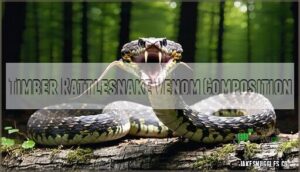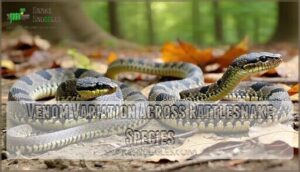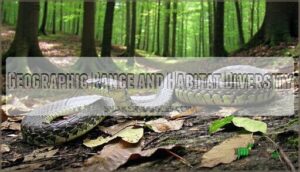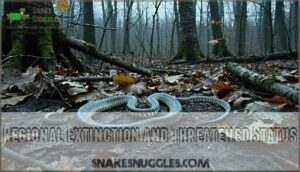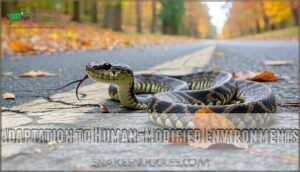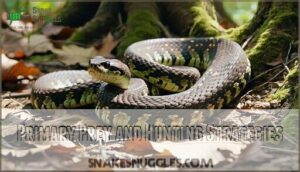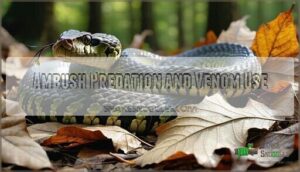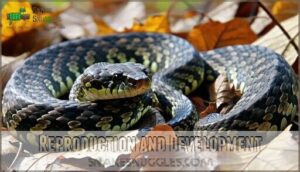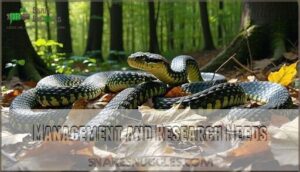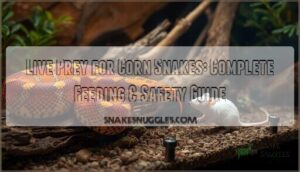This site is supported by our readers. We may earn a commission, at no cost to you, if you purchase through links.

Geographic location dramatically shapes their chemical cocktail—northern populations pack more neurotoxic punch that attacks your nervous system, while southern rattlers lean heavily on hemorrhagic toxins that mess with blood clotting.
It’s like nature’s own regional recipe book, with each population fine-tuning their venom over thousands of years to match local prey and environmental pressures.
This isn’t just academic curiosity; understanding these variations could save your life during an encounter and reveals how evolution crafts the perfect predatory tool.
Table Of Contents
- Key Takeaways
- Timber Rattlesnake Venom Composition
- Venom Variation Across Rattlesnake Species
- Evolution of Toxin Gene Families
- Timber Rattlesnake Habitat and Distribution
- Diet and Foraging Behavior
- Reproduction and Development
- Conservation Status and Threats
- Management and Research Needs
- Human-Rattlesnake Conflict and Safety
- Frequently Asked Questions (FAQs)
- Do different rattlesnakes have different venom?
- What is the difference between timber and canebrake?
- What rattlesnake has the most toxic venom?
- What type of venom do timber rattlesnakes have?
- What is the difference between a canebrake and a timber rattler?
- What rattlesnake has the most potent venom?
- How does timber rattlesnake venom affect the human body?
- Can timber rattlesnakes control their venom output?
- Are there regional differences in antivenom effectiveness?
- How often do timber rattlesnakes shed their skin?
- Conclusion
Key Takeaways
- You’ll find timber rattlesnake venom varies by region—northern snakes pack more neurotoxic venom, while southern ones rely on hemorrhagic toxins.
- Each snake can have one of four venom types, ranging from pure neurotoxic to hemorrhagic, mixed, or barely toxic, directly affecting bite symptoms and treatment.
- These venom differences come from rapid gene evolution, letting each population adapt its venom to local prey and environmental pressures.
- Standard antivenoms don’t always work equally well across regions because of these venom variations, so knowing local venom types can be critical in emergencies.
Timber Rattlesnake Venom Composition
You’ll discover that timber rattlesnake venom isn’t just one deadly cocktail—it’s actually four distinct types with wildly different effects on your body.
Understanding these venom variations helps explain why some bites cause paralysis while others destroy tissue, and why scientists consider these snakes living laboratories of evolutionary adaptation.
Venom Classification and Types
The timber rattlesnake venom packs a deadly punch as type II classification—highly lethal without hemorrhagic chaos.
You’ll encounter four distinct venom types that showcase nature’s toxic artistry:
- Type A – Pure neurotoxic power with canebrake toxin
- Type B – Hemorrhagic tissue destroyer, most common
- Type A+B – Mixed effects, less lethal combination
- Type C – Minimal toxicity, rare weakling
Each venom composition tells an evolutionary story of survival.
Understanding the nuances of snake venom composition by species provides valuable insights into the diverse effects of venom on human health.
Dominant Toxin Classes and Their Effects
Understanding timber rattlesnake venom composition starts with knowing the three main toxin classes that make this snake’s bite so dangerous.
Each class targets different body systems, creating a deadly cocktail that can quickly overwhelm your defenses.
Here’s what you’re dealing with:
- Snake Venom Serine Proteases (SVSPs) – These disrupt your blood’s clotting ability, preventing wounds from healing properly
- Phospholipases A2 (PLA2s) – They attack cell membranes, causing tissue damage and intense pain throughout your body
- Bradykinin-Potentiating Peptides (BPPs) – These drop your blood pressure dangerously low, potentially causing shock
These toxin classes work together in timber rattlesnake venom, creating biochemical reactions that affect multiple organ systems simultaneously.
The venom potency depends on which toxin classes dominate the composition.
Evolutionary Differences in Venom Types
Evolution hasn’t been kind to timber rattlesnakes in the context of venom adaptation. You’ll find Type A venom packs a neurotoxic punch with canebrake toxin, while Type B venom tears through tissue with hemorrhagic compounds.
This toxin evolution stems from dramatic shifts in gene expression patterns—Type A snakes basically shut down their hemorrhagic toxin genes, focusing on serine proteinases instead.
Molecular diversity tells the story: Type A venom’s genetic simplicity contrasts sharply with Type B’s complex redundancy, showing how phylogenetic analysis reveals nature’s deadly trade-offs.
Venom Variation Across Rattlesnake Species
You’ll find that timber rattlesnakes aren’t the only venomous snakes with deadly cocktails – different rattlesnake species have evolved unique venom recipes that reflect their hunting needs and evolutionary history.
While timber rattlesnakes show dramatic variation between their neurotoxic Type A and hemorrhagic Type B venoms, other species like eastern diamondbacks have developed their own specialized toxin profiles that make each encounter potentially unpredictable.
Comparison of Timber Rattlesnake and Eastern Diamondback Rattlesnake Venom
When you compare these two venomous giants, you’ll find striking differences in their snake venom toxicity.
This difference is evident in the composition of their venom: Eastern diamondback rattlesnake venom contains over 100 different toxins, creating a complex hemorrhagic cocktail that destroys tissue rapidly.
In contrast, timber rattlesnake venom composition is simpler yet deadlier—its neurotoxic punch can paralyze prey instantly.
This venom evolution reflects each species’ hunting strategy and ecological niche, and understanding the unique characteristics of snake venom types is essential for appreciating the nuances of these species.
Factors Influencing Venom Variation
You’ll find that genetic variation creates the foundation for different venom types, while environmental factors and diet influence shape what works best in each habitat.
Geographic isolation drives molecular evolution, allowing populations to develop specialized venom compositions.
Timber rattlesnake venom variations reflect these pressures, with snake venom research revealing how rattlesnake venom components adapt to local prey and conditions.
Implications for Speciation and Evolution
You’ll witness how timber rattlesnake venom variations drive species divergence through fascinating evolutionary pressures.
Molecular phylogeny reveals that venom adaptation doesn’t just happen randomly—it’s shaped by genetic drift and gene regulation patterns that create distinct lineages.
Here’s how venom evolution impacts speciation:
- Adaptive radiation occurs when populations develop specialized toxin profiles for different prey types
- Evolutionary pressures from habitat isolation create unique venom compositions across geographic ranges
- Gene regulation changes allow rapid adaptation without major structural mutations
- Species divergence accelerates when venom types become reproductively isolated through behavioral differences
- Molecular phylogeny studies show venom genes evolve faster than other genetic markers, acting as speciation drivers
Evolution of Toxin Gene Families
You’ll discover that timber rattlesnake venom genes don’t just randomly mutate—they evolve under intense pressure to become more effective killers.
The PLA2 and SVSP gene families undergo rapid changes through gene duplications, deletions, and positive selection that fine-tune their deadly chemistry.
PLA2 and SVSP Gene Families in Timber Rattlesnakes
Timber rattlesnake’s toxin evolution relies heavily on PLA2 and SVSP gene families working together like a deadly molecular tag team.
These gene families undergo rapid molecular adaptation through specialized venom gene regulation patterns.
Here’s how these families drive venom complexity:
- PLA2 genes manipulate cell membranes and enhance protease function
- SVSP genes disrupt blood coagulation through precise gene expression control
- Combined action creates timber rattlesnake venom variations across geographic populations
This molecular teamwork makes their venom incredibly effective at immobilizing prey.
Gene Gain and Loss Events in Toxin Evolution
Evolution never stops reshaping timber rattlesnake venom through Toxin Gene Duplication and Gene Loss events.
Molecular Evolution drives these changes as Gene Expression patterns shift, creating new toxin variants while eliminating others.
Toxin Diversification occurs when genes duplicate, allowing Gene Regulation to fine-tune venom cocktails for specific prey.
This dynamic process explains why timber rattlesnake venom varies so dramatically across populations, with venom evolution constantly adapting through strategic gene gain and loss.
The study of venom gland transcriptomics reveals the complex mechanisms behind these venom variations.
Positive Selection Acting on Toxin Genes
Beyond gene duplication and loss events, positive selection drives timber rattlesnake venom evolution by favoring advantageous mutations.
Evolution crafts deadly precision through nature’s relentless selection pressure, transforming venom into the ultimate biological weapon.
You’ll find toxin genes undergo rapid molecular adaptation, with higher nonsynonymous mutation rates than non-toxin genes.
This selection pressure creates venom diversification across populations, optimizing hunting efficiency for different prey types.
Here’s how positive selection shapes toxin gene evolution:
- Environmental pressures – Prey availability and habitat differences drive selection for specific venom variants
- Molecular adaptation – Beneficial mutations in gene expression patterns get preserved and amplified
- Functional optimization – Toxin genes evolve to maximize effectiveness against local prey species
Timber Rattlesnake Habitat and Distribution
You’ll find timber rattlesnakes across a surprisingly wide range, from Kansas to Georgia, thriving in forests, swamps, and even agricultural fields.
Unfortunately, they’re facing serious trouble – these snakes have vanished from Canada entirely and are now threatened or endangered in multiple states due to habitat loss and human expansion.
Geographic Range and Habitat Diversity
Across eastern United States, you’ll find timber rattlesnakes thriving in remarkably diverse ecosystems.
These adaptable serpents inhabit deciduous forests, rocky hillsides, swampy lowlands, and agricultural edges from Minnesota to northern Florida.
Their geographic variation drives distinct timber rattlesnake venom variations as populations adapt to local prey and environmental pressures.
| Region | Primary Habitat | Elevation Range | Climate Zone | Conservation Status |
|---|---|---|---|---|
| Northern Range | Deciduous forests, rocky outcrops | 200-3,000 ft | Temperate | Threatened/Endangered |
| Central Range | Mixed oak-pine forests, farmland edges | 500-2,500 ft | Humid continental | Stable to declining |
| Southern Range | Swamps, cane fields, bottomlands | 0-1,500 ft | Subtropical | Locally threatened |
| Appalachian | Mountain forests, cliff faces | 1,000-4,000 ft | Montane | Protected populations |
| Western Edge | Prairie edges, river bottoms | 500-2,000 ft | Continental | Rare/extirpated |
Regional Extinction and Threatened Status
You’re witnessing something alarming – timber rattlesnake populations are vanishing across their historic range.
These threatened species face extinction risk from multiple pressures, creating a conservation crisis that demands immediate attention.
Current regional extinction and threatened status:
- Complete extirpation – Maine, Delaware, Rhode Island, and Ontario lost all populations
- Severe habitat fragmentation – 60% population decline in New York alone
- Conservation status – Endangered in seven states, threatened in five more
- Isolated populations – Only 17% of New York dens maintain "good" status
Human persecution and habitat loss drive species decline, making conservation efforts absolutely necessary for survival.
Adaptation to Human-Modified Environments
Timber rattlesnakes face habitat fragmentation and urbanization effects that challenge their survival.
These adaptable serpents modify their behavior in human-modified environments, adjusting hunting patterns and shelter selection to avoid road mortality. Their environmental adaptation strategies demonstrate remarkable resilience in human-dominated landscapes.
To create suitable environments for these snakes, understanding proper snake habitat design is essential for their wellbeing.
| Environmental Challenge | Snake Response | Conservation Impact |
|---|---|---|
| Habitat fragmentation | Altered movement patterns | Reduced genetic diversity |
| Road mortality | Crossing behavior changes | Population decline |
| Urbanization effects | Modified denning sites | Habitat quality loss |
| Human impact | Behavioral flexibility | Adaptation success |
| Food scarcity | Dietary adjustments | Survival rates |
Diet and Foraging Behavior
You’ll discover that timber rattlesnakes are incredibly efficient predators, using their deadly venom to subdue prey ranging from mice and squirrels to birds and small mammals.
Their ambush hunting strategy relies on perfect timing—they’ll wait motionless for hours before striking with lightning speed, injecting venom that quickly immobilizes their next meal.
Primary Prey and Hunting Strategies
When you’re tracking timber rattlesnake prey selection, you’ll find they target small to medium-sized rodents like mice, shrews, and chipmunks.
These snakes use specialized hunting tactics centered on patience and precision.
Their foraging behavior revolves around ambush strategies – they’ll position themselves along rodent trails and wait.
Once prey appears, their venom delivery system immobilizes victims quickly, making their rattlesnake behavior incredibly efficient for survival.
Ambush Predation and Venom Use
You’ll find timber rattlesnakes are masters of patience, lying motionless for hours until unsuspecting prey wanders within striking distance.
Their ambush strategies rely on precise venom delivery—each bite injects potent toxins that cause rapid prey immobilization.
This hunting tactic maximizes energy efficiency while their timber rattlesnake venom variations guarantee effective prey capture across different habitats and species.
The unique composition of their venom is related to rattlesnake venom properties that have been studied extensively.
Dietary Adaptations and Specializations
You’ll discover that timber rattlesnake venom biochemistry directly shapes their dietary specializations.
Their prey capture becomes more efficient when venom potency matches specific prey types.
Their hunting strategies adapt to available food sources, with prey-specific adaptations enhancing success rates.
This venom variation reflects evolutionary pressures, optimizing foraging behavior for maximum energy return while minimizing risk during strikes.
Reproduction and Development
You’ll find that timber rattlesnakes have evolved one of nature’s most fascinating reproductive strategies, with females giving birth to live young rather than laying eggs.
Their reproductive cycle directly connects to venom potency—females invest tremendous energy into producing offspring that arrive already equipped with deadly, fully functional venom systems.
Mating Season and Female Reproductive Cycle
During spring through late summer, you’ll witness timber rattlesnakes’ fascinating mating habits as males compete for females through ritualized combat dances.
Female reproductive cycles span 2-3 years, with sexual maturity reached around age 5.
This extended breeding pattern guarantees reproductive success while conserving energy for venom production, creating an intricate balance between reproductive health and maintaining potent timber rattlesnake venom variations essential for survival.
Viviparity and Litter Size
Once mating’s complete, you’ll witness timber rattlesnakes’ remarkable viviparity in action. Unlike egg-laying species, these snakes give birth to fully-formed live young after an 8-9 month gestation period.
Their reproductive biology shows fascinating patterns:
- Birth rates average 7.6 offspring per litter, though maternal health influences this number
- Litter size ranges from 3-13 neonates, with larger females producing more young
- Reproductive cycles occur every 2-3 years, allowing mothers to recover between pregnancies
Environmental factors like food availability directly impact neonate care success and timber rattlesnake venom development in offspring. The unique process of snake reproductive methods plays a vital role in the survival of the species.
Neonate Development and Growth
You’ll watch newborn timber rattlesnakes enter the world as deadly miniatures, already armed with potent venom despite their 7-10 inch length.
These neonates don’t need mom’s help—they’re born hunters with fully functional fangs and venom maturation that’s surprisingly advanced.
Growth rates accelerate rapidly when they successfully capture small prey like mice and shrews, with hatchling survival depending entirely on their hunting skills during those first critical weeks.
Conservation Status and Threats
You’ll find that timber rattlesnakes face serious conservation challenges across their range, with populations declining rapidly due to habitat destruction and human persecution.
These remarkable venomous snakes are now classified as endangered or threatened in twelve states, making their protection essential for maintaining ecosystem balance.
IUCN Red List Classification and State-Level Threats
The IUCN Red List labels timber rattlesnakes as "Least Concern," but you shouldn’t let that fool you.
This endangered species faces serious state-level threats across its range, with conservation status varying dramatically by region.
Threat assessment reveals declining populations despite the global classification, making habitat protection and conservation efforts essential for species survival.
- Seven states now list timber rattlesnakes as endangered, including Virginia and Massachusetts
- Population declines of 50-75% have occurred in New York alone
- Extirpation has already happened in Michigan, Delaware, Maine, and Rhode Island
- Timber rattlesnake venom variations make each population genetically irreplaceable once lost
Habitat Loss and Urban Development
Urban sprawl destroys critical timber rattlesnake habitat through habitat fragmentation and environmental degradation.
You’ll find that human impact creates scattered forest patches, forcing snakes into smaller territories where survival becomes challenging.
Ecosystem disruption from urban development eliminates denning sites and prey corridors, making human-wildlife conflict inevitable as desperate snakes venture into developed areas seeking resources.
Hunting and Human-Rattlesnake Conflict
Unfortunately, human-rattlesnake conflict escalates when hunters target these endangered serpents.
Despite hunting regulations in most states, illegal collection for the pet trade continues threatening populations.
Rattlesnake attacks on humans remain rare, but snake bites occur when people encounter defensive snakes.
Gopher snakes, often mistaken for rattlesnakes, also play a role in rodent population control.
Effective wildlife management requires conflict resolution strategies emphasizing human safety while protecting these venomous predators and their complex timber rattlesnake venom systems.
Management and Research Needs
You’ll need effective conservation strategies to protect timber rattlesnakes and understand their remarkable venom evolution.
Scientists are working on three key areas: preserving critical habitats, studying how different venom types developed across populations, and teaching people why these misunderstood serpents matter for healthy ecosystems.
This includes understanding the importance of ecosystems and how timber rattlesnakes contribute to them.
Habitat Protection and Restoration
Three key strategies protect timber rattlesnakes from habitat fragmentation and declining prey availability.
You’ll need forest management practices that maintain swamp conservation areas while reducing road mortality through wildlife corridors.
Environmental conservation efforts must address habitat protection by creating connected landscapes.
Effective conservation planning balances human development with timber rattlesnake venom research needs, ensuring these species survive habitat challenges.
Research on Venom Evolution and Speciation
You’re witnessing a scientific revolution in understanding snake venom evolution.
Current research focuses on five key areas:
- Venom gene duplication patterns across timber rattlesnake populations
- Geographic venom variation mapping through comparative genomics
- Toxin expression evolution mechanisms driving venom type divergence
- Gene families under positive selection in different habitats
- Speciation mechanisms linking venom phenotypes to evolutionary differences
These studies reveal how environmental pressures shape deadly toxin cocktails over time.
Education and Outreach Programs
Building on research efforts, public awareness campaigns and venom education programs protect both timber rattlesnakes and communities.
These conservation outreach initiatives foster community engagement while teaching rattlesnake safety fundamentals.
- School partnerships deliver snake awareness curricula covering timber rattlesnake venom variations and bite prevention
- Community workshops train residents in habitat identification and safe coexistence practices
- Citizen science projects engage volunteers in monitoring local rattlesnake populations and behavior patterns
Human-Rattlesnake Conflict and Safety
Despite their fearsome reputation, timber rattlesnakes rarely attack humans unless threatened or cornered.
You’ll face the greatest risk when accidentally stepping on or handling these venomous serpents, making awareness and proper safety measures essential for peaceful coexistence.
Assessment of Risk to People and Pets
Understanding timber rattlesnake bite severity helps assess real risks to you and your pets.
Geographic risk varies substantially—southern populations with Type A timber rattlesnake venom pose greater neurotoxic threats than northern variants.
Pet vulnerability increases due to their curiosity and smaller body size, making venom exposure more dangerous.
You’ll face higher risks during spring emergence and fall migrations when snakes are most active.
Prevention and Treatment of Rattlesnake Bites
Step back from the fear factor—prevention beats cure every time.
Most rattlesnake encounters end peacefully when you wear proper footwear and stay alert on trails.
Bite First Aid essentials:
- Keep bitten limb below heart level and remove tight items
- Call 911 immediately—antivenom is the only effective snake venom treatment
- Ignore snakebite myths about cutting or sucking wounds
Medical intervention with antivenom options saves lives, while risk reduction through rattlesnake safety awareness prevents emergencies altogether.
Some people also seek additional bite remedies.
Coexistence With Timber Rattlesnakes in Shared Spaces
Living alongside timber rattlesnakes requires smart strategies and mutual respect.
You’ll create snake-human harmony through education programs that teach proper identification and safe distancing techniques.
- Habitat preservation – Maintain natural areas while implementing responsible development practices that protect denning sites and reduce human-snake encounters through strategic snake relocation when necessary.
Frequently Asked Questions (FAQs)
Do different rattlesnakes have different venom?
Like comparing apples to oranges, you’ll find rattlesnake venoms differ dramatically between species.
Each rattlesnake’s developed unique venom cocktails targeting their specific prey and environments, creating distinct toxin profiles that affect victims differently.
What is the difference between timber and canebrake?
Timber rattlesnake and canebrake are the same species—Crotalus horridus.
"Canebrake" refers to southern populations, while "timber" describes northern ones.
You’ll find canebrake toxin in southern snakes, making their venom more neurotoxic than their northern cousins.
What rattlesnake has the most toxic venom?
Among North American rattlesnakes, you’ll find the timber rattlesnake’s Type A venom most lethal.
It contains canebrake toxin, delivering pure neurotoxic effects that shut down your nervous system faster than other rattlesnake venoms.
What type of venom do timber rattlesnakes have?
You’ll encounter four distinct venom types in timber rattlesnakes: Type A (neurotoxic), Type B (hemorrhagic), Type A+B (mixed), and Type C (minimal toxicity).
Each type delivers different effects through specialized toxin combinations.
What is the difference between a canebrake and a timber rattler?
No difference exists – they’re the same species with regional names. "Canebrake rattlesnake" refers to southern populations, while "timber rattlesnake" describes northern ones, though both are Crotalus horridus.
What rattlesnake has the most potent venom?
Like a viper’s deadly lottery, you’ll find the Eastern diamondback rattlesnake packs the most potent punch.
However, Type A timber rattlesnakes with canebrake toxin actually deliver more lethal neurotoxic venom than their hemorrhagic cousins.
How does timber rattlesnake venom affect the human body?
Timber rattlesnake venom disrupts your blood’s clotting ability while attacking cell membranes and dropping blood pressure.
You’ll experience tissue damage, internal bleeding, and potentially life-threatening cardiovascular collapse without prompt medical treatment.
Can timber rattlesnakes control their venom output?
Yes, timber rattlesnakes can control their venom output.
You’ll find they regulate how much venom they inject based on threat level and prey size, sometimes delivering "dry bites" with no venom at all.
Are there regional differences in antivenom effectiveness?
You’d think one antivenom would handle all timber rattlesnakes, but you’re wrong. Regional venom variations mean standard antivenoms work better against some types than others, creating treatment gaps.
How often do timber rattlesnakes shed their skin?
Adult timber rattlesnakes shed their skin approximately every 1-2 months during active seasons, with juveniles shedding more frequently as they grow rapidly. You’ll notice fresh rattles appear after each shed.
Conclusion
Nature’s deadliest chemistry lab operates in your backyard—timber rattlesnakes have evolved venoms so precisely adapted to geography that they’re practically custom-designed biological weapons.
These timber rattlesnake venom variations represent thousands of years of evolutionary fine-tuning, creating northern populations with nerve-attacking neurotoxins and southern snakes wielding blood-disrupting hemorrhagic cocktails.
You’re witnessing evolution’s masterpiece in action, where survival demands the perfect chemical balance for each unique environment and prey base.
- https://avmajournals.avma.org/view/journals/javma/262/4/javma.23.11.0642.xml
- https://animalia.bio/timber-rattlesnake?letter=c
- https://ferrebeekeeper.wordpress.com/2012/11/09/the-timber-rattlesnake/
- https://wsed.org/viperid-spotlight-timber-rattlesnake-crotalus-horridus/
- https://pmc.ncbi.nlm.nih.gov/articles/PMC8625053/

